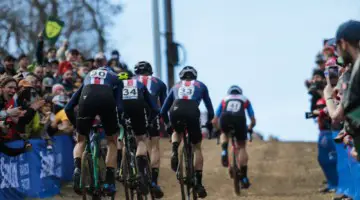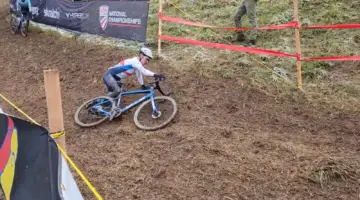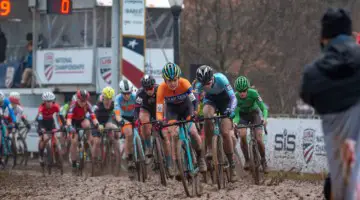Readers might remember the controversy of how the 80% Rule was used in the amateur races at the 2016 JingleCross. Cyclocross Magazine brought attention to the well-articulated complaints by Steve Tilford on the rule’s implementation at the race. Readers might also remember the 80% Rule controversy at Austin’s National Championships in three-category Junior race on Monday that brought tears even to unsuspecting, pulled winners.
After we published the Tilford op-ed, USA Cycling responded, saying:
“We understand and appreciate our ’cross community’s concerns regarding the 80% rule. We are reviewing the application of the rule and, in particular, when and how it is implemented. We will have recommendations shortly to address these concerns.”
USA Cycling has followed through on that promise, and now has a “CX Best Practices” document available for race directors and officials that’s quite comprehensive in explaining when and how the rule should be used, as well as clearly outlining situations, like the one at Jingle Cross, when the rule should not be implemented.
After reading the document, one scenario that was still unclear to us was whether implementation of the 80% Rule would be implemented in all categories at the 2017 Hartford USA Cycling Cyclocross National Championships. We followed up with Chuck Hodge, USA Cycling’s Technical Director, and while final decisions haven’t been made, Hodge said the team is leaning heavily towards “limiting the 80% rule to the “UCI Elite categories.” (UCI categories are the Elite men and women, U23 men, Junior 17-18 men and Women’s Youth/U23.)
Although not final, that update should be good news for age group racers and racers considering in participating at Nationals but not expecting to win a title.
See USA Cycling’s verbatim recommendations below, with select Cyclocross Magazine pull quotes.
CX Best Practices For Race Director and Officials
CX Best Practices is a summary of thoughts developed between Cyclo-cross Race Directors, Officials and Staff in order to create greater understanding of the impacts of decisions by both Race Directors and Officials at Cyclo-cross races. USA Cycling has received several inquiries and complaints regarding the handling of lapped riders and results at the start of the 2016 Cyclo-cross season. It is clear that there is no one reason for these issues, but rather that there are numerous causes related to interpretation of the regulations, scheduling of events and communication amongst all parties involved.
Use of these best practices will provide for greater national uniformity, and a better racer experience.
Rider Finishes
USA Cycling regulations allow for three different methods for handling rider finishes:
- Riders may be left in, and scored by place and laps down (4G1)
- Riders who get lapped, are pulled AFTER they are lapped when they reach an area before the finish (4G1(a))
- Rider are pre-emptively pulled based on the 80% rule, and are not allowed to get lapped (4G1(b))
Agreement on which method is appropriate must be discussed between the lead Official and Race Director, and should be relayed to riders as early as possible with a mandatory notification on the line.
Items to consider:
- Level of race (eg. UCI Elite field vs. lower category amateur)
- Schedule restrictions
- Number of starters
- Number of staggered starts/waves within a race
- Lap times
- Course type (tight and technical, wide open, etc.)
- Desires of the Race Director
- Type and quality of timing/scoring system
- Number of officials
- Weather / deteriorating course conditions
Use of 80% Rule
The 80% rule is used when preserving the quality of competition among the leading riders in a race is the primary consideration. Pulling riders before they are lapped eliminates race leaders from being interfered with, and creates a “clean course” ahead, allowing the races to finish on the strengths of the leading group with less chance of outside interference. As a reminder, use of the 80% rule is only required at UCI World Cups and World Championships (UCI 5.1.052).
Otherwise both UCI and USAC regulations require that the Chief Official discuss the use of this rule with the Race Director. Thus the focus should be on the more elite side of the sport, not amateur racing.
Use of this method means that riders out of contention will have a shorter race experience, something that is not the desired result for amateur or participation based categories and races. Ideally the start of this conversation is done well before the event so that proper communication on both sides may take place. It is common and accepted practice that the 80% rule will be used for the UCI registered categories at a given race.
If used, it is also crucial that the 80% rule be applied correctly. As noted in the USAC regulations, the use of 80% is an approximation. The goal is to pull riders as late as possible without having them caught on the next lap. Officials should strive to let riders have as much time on course as possible. The most crucial time to apply the 80% rule is in the last few laps to ensure that the winners are not impeded and that the winner is crossing the line without lapped traffic. It is important to look for natural breaks between riders in order to apply the 80% pull with skill and understanding of the race
It should also be noted that riders who pass the finish line before the race leader comes in for a finish should be allowed to complete their final lap, as there is no chance of them being lapped. The race schedule should allow for this (see detail below).
In short, it is USA Cycling policy that the 80% rule should only be used in elite level racing. The 80% rule should not be used for participation based amateur events, unless requested by the race organization in discussion with the Chief Referee. It is recommended that such information be placed in the official race announcement if it will be enforced outside of UCI events.
Allowing All Riders to Continue
In most races, it is appropriate to allow all riders to continue after they are lapped. This may be for a particular category, or an entire race day. This allows riders to “get their money’s worth”, even if they are not competing for the race win or podium. This method of finish should be considered when working amateur events, races with small fields, races with multiple categories and/or staggered starts and less technical courses. Somewhat as critical is the Race Director’s design of a less technical course. (wider throughout, fewer dismount sections or features requiring advanced skill levels of the competitors)
Allowing lapped riders to continue often results in more work for the timing company and race officials. For large or multi-category races where riders are not pulled, Race Directors should be prepared to provide appropriate timing resources and/or additional officials (or both). As the correct finish result is what people are racing for, it should be remembered that in finishing the results for one event (especially with multiple categories) can remove one judge from the results and scoring process to resolve any protests. At the same time, the schedule, set by the Race Director, requires that another one has already started. Good results happen when adequate resources are applied.
Example 1
Scenario: The Men’s U23 race at CX Nationals has 80 starters. The leader rides the first two laps at an average of 7 minutes.
As this is an elite-level race where the podium is crucial, the 80% rule would be applicable. Riders would be pulled when they are approximately 5:36 behind the leader. Riders who make it through before the leader on the last lap should continue.
Example 2
Scenario: The race is an amateur Masters race at a UCI CX “race weekend”. The race contains 35+ and 55+ masters, who are scored separately. The combined field size is 120 riders and it is anticipated that lap times will be around 8 minutes. The organizer has staged the 35+ in front of the 55+ riders on the line and they are starting at the same time.
This is an amateur event, regardless of its schedule in conjunction with a UCI registered event. The 80% regulation should not need to be applied and in fact will create a negative experience for the participants. Doing so will result in many of the 55+ field getting pulled – sometimes leaving just a few of them to contest the actual finish, perhaps accidentally removing the second race’s leader. This is a case where leaving riders in and scoring them as they go down would be more appropriate, with all riders finishing on the leader’s lap.
“The 80% regulation should not need to be applied and in fact will create a negative experience for the participants.”
Example 3
Scenario: The race is a local CX race. The race contains juniors from 9-18. The organizer has a 15-18 group starting first, with a 9-14 group starting 30 seconds later. The combined field size is 30 riders and it is anticipated that laps times for the 15-18 field will be around 8 minutes.
Again, this is an amateur event with combined fields. If the 80% rule is applied here, there will be tears! In this case we have two fields of widely differing abilities starting separately. The younger juniors, who we know are going to lose time against the older juniors, are starting at a disadvantage. If you use 80% of the LEADER’S time you will also be putting the later starting group at a further disadvantage. In this case it would be wiser to go ahead and start everyone at once or with a reduced small gap (with consultation between the race director and chief referee), and let them race without being pulled. A good practice is to line the separate starting fields up separately so the riders in each group can identify their competitors and not feel like they are lost among the larger field of competitors. Local race, young kids – let them enjoy racing their bikes.
“Again, this is an amateur event with combined fields. If the 80% rule is applied here, there will be tears!
Local race, young kids – let them enjoy racing their bikes.”
Scheduling and Timing
Timing of Races
In order to provide consistency for Race Director scheduling and racer preparation, it is important to consider how race times are calculated once the race is underway. Typically, the time of the first or first and second lap average is used, with a calculation made so that the number of laps raced will result in a finish time for the winner close to the published running time of the event. For events over 40-45 minutes, it is best to use an average of the first two laps. The following items should be considered by both officials and the Race Director:
- What is the course length and expected lap time?
- How much time is allotted between races?
- Will there be a major lap time difference between the first and last rider on the lap?
- Is it possible lap times will drastically slow during the race (deteriorating course and weather)?
Example:
A race is scheduled at 9:00 am and is to be 40 minutes long. If the leader is riding 7:00 minute laps and the race is 40 minutes, the race will be 6 laps long, or 42 minutes. However, the final rider that does not get lapped may ride a 8:00+ minute lap – so the running time of the race would actually be 50 minutes (42:00 + 8:00). If the plan is to start the next race at 9:45 am, this presents a conflict.
When scheduling races, the following should be considered:
- The starting grid should be separate from the race course, as this allows for staging the next race while finishing another.
- Is enough time built in for the last rider on course to complete a lap after the leader has finished?
- How is warmup handled and how much time is built in for course inspection for the next starting group?
Scheduling Races and Categories
The following suggestions have been made by experienced Race Directors and shown to be effective when scheduling events:
- If combining categories or age groups into one race, try to run categories of similar abilities and speed. As an example, older juniors might be competitive with some Masters categories. Even if these groups are scored separately, the fact that the race may not “blow apart” will create less conflict with lapped riders.
- Make sure that number sequences of groups who race together but are scored separately are different and easily recognizable. For example, if Masters 35+ and 55+ are racing together, it would be ideal to have one group’s number as something like 301-350 and the second as 501-550. This makes it much easier for the officials, riders, and timing company to identify who is in each category. A differing colored band or sponsor lettering on the number that is different between categories is also very helpful, particularly to the riders. If a rider with a blue band on the number knows he is not racing the person next to him with a red band (different category racing at the same time) it helps the competition of the race. It might also be useful to start one group with numbers counting up (ascending) and another counting down – this helps keep the secondary digits from replicating (and makes scoring easier). For example, go up from 101 for one race and down from 299 for another.
- Please consider your field limits. Putting 200 riders on a course may be legal – but might not be the best idea for rider experience. Making a course long/slow to accommodate large fields impacts the ability to pit often, and creates a really long “tail end” after the leader comes through that must complete a final lap.
- When racing multiple fields at once, finishing all riders after the leader/winner of the first field finishes helps to conserve time, while still giving a full race experience to others.
- “Staggered starts” within a wave are sometimes necessary, but the number of such starts in each wave should be as small as possible and the interval between starts should be short. Many of the conflicts with lapped riders are the result of groups starting several minutes after the first set of starts in their wave. For example, starting 4 groups on a 7-minute course with a minute in between puts the final group half a lap down before the race even starts. It is critical to remember suggestion 1, above, when creating the groups that will ride together.
Example: Consider how the following scheduling of a wave impacts how the race is handled:
Scenario: A race is scheduled with a Women 1/2, Women 3, and Women 4 race at the same time. These three categories will have staggered starts with the waves at around 1:00 apart. It is anticipated that course times will be around 7 minutes for the leader and is 40 minutes total.
Some items to consider:
- Realize that the Women 4 will already be around 2:00 down as the race starts. In this scenario many of them will be lapped.
- Implementing the 80% rule or pulling riders as they are lapped by the overall race leader will results in many riders in the 2nd and 3rd start being pulled
- The leader of the race is going to have “traffic” to race through.
- Realistically, race officials will not be able to pull without affecting the leaders of the later starting individual races.
- Having distinctly separate race numbers for the different starts will help tremendously with scoring the race and producing results. For example: 201, 301 and 401 as the starting number for the different categories, preferable with a different colored sponsor logo or colored band.
- You should anticipate the lap time of the slowest category when considering how long after the leader finishes the course will remain active.
- Both the timing company and officials will have to devote time to sorting out rider places and categories after the finish. This will result in the need for more resources.
For this race, the leaders will ride 6 laps (6 laps x 7:00= 42 minutes). Remember that the slowest rider will do a lap in 8:00+, and that we are allowing riders who make it through before the leader’s finish to continue, this race will actually take around 50 minutes to complete.
It is understandable that race directors want to stage races in this manner, however when doing so both the race director and officials should understand and anticipate the issues above and plan on how to handle them. We should strive to never have to pull riders in this type of race.
Communication among both parties and the riders goes a long way towards setting expectations.
Cyclo-cross season is very unforgiving when the schedule uses all available daylight hours! If a race creates a delay; accident, staging, registration, results, protests, course reset, etc., then it is presumed that the remaining events will be shortened to utilize the time available. Again, this is a communication issue for both the Official and the Race Director in managing a successful event.
Thank you for taking the time to review this information and we hope it assists in creating better cyclo-cross events for the Race Director’s customers as well as a smoother, more predictable and professionally managed events by the Officials.
Read more about the events at JingleCross that led to these new, well-reasoned 80% rule guidelines here.



























